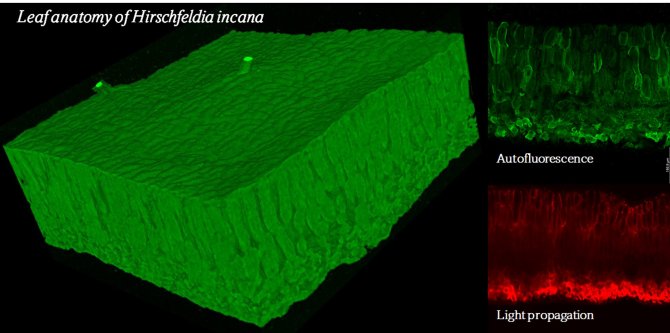
Project
Modelling the high photosynthesis of Hirschfeldia incana
The species Hirschfeldia incana is used in the Extremophile program of Wageningen University as a model species with a remarkably high rate of photosynthesis under high light. To unravel the anatomical and biochemical basis of the high photosynthesis performance, we apply a multi-factor model that incorporates: a virtual leaf tissue generator, a 3D microscale reaction-diffusion model of gas transport, a light propagation model, and an extended version of the Farquhar-von Caemmerer-Berry model for photosynthesis.
Background
Plants performing well under high light intensity must maintain a high quantum yield for photochemistry at high irradiances. At the same time, the biochemical carbon fixation must be efficient. In all cases these plants also require a high rate of physical transport of CO2 to the carboxylation site and efficient recycling of CO2 that arises from (photo)respiration. The latter aspects are very strongly influenced by biochemistry, leaf anatomical factors and the positioning of different organelles within the mesophyll cells of C3 plants. However, which aspects (photochemical, biochemical, physical, and anatomical) (co)contribute most to the high photosynthetic productivity and plasticity of Hirschfeldia incana is yet to be unravelled.
Project description
During photosynthesis, light energy is converted into chemical energy, which is then mainly used for the fixation of carbon dioxide. Insights into the quantitative aspects of photosynthesis and CO2 exchange have benefited tremendously from advanced modelling approaches such as the seminal biochemical model of Farquhar, Von Caemmerer and Berry. This model has been applied to explore a wide diversity of biologically relevant photosynthesis-related parameters such as mesophyll conductance.
Modern techniques have progressed far enough to start to embrace the complexity of 3D diffusion in leaves. Our group, together with colleagues from the University of Leuven (Belgium), has developed several types of 1D, 2D and 3D models of light propagation, CO2 diffusion and photosynthetic capacity at the microscale level of individual leaves. These models can be used for different research questions, including simpler 2D simulations as well the computationally more demanding 3D simulations.
At the basis of the approach are tools to simulate realistic microstructures of leaves and we have demonstrated in the past that we can successfully use several virtual leaf microstructures. These range from a simplified structure that is easy to a virtual geometric representation based on a virtual leaf tissue generator extending up to a range of geometric representations of leaf microstructures obtained with either laminography techniques.
The multi-factor model analysis will allow us to comprehensively explore the effects of different anatomical features on photosynthesis, photorespiration, the re-use of (photo)respired CO2, mesophyll conductance, the possible effects of carbonic anhydrase and aquaporins, cell wall thickness, etc. The actual microgeometry, anatomy and photosynthetic characteristics will be used to refine the model-based analysis of the impact of microstructure on the 3D aspects of leaf photosynthesis and to validate the different (sub)models.
Results
